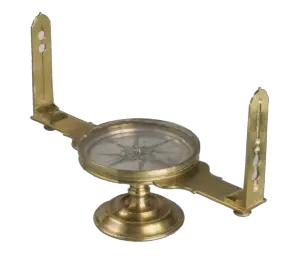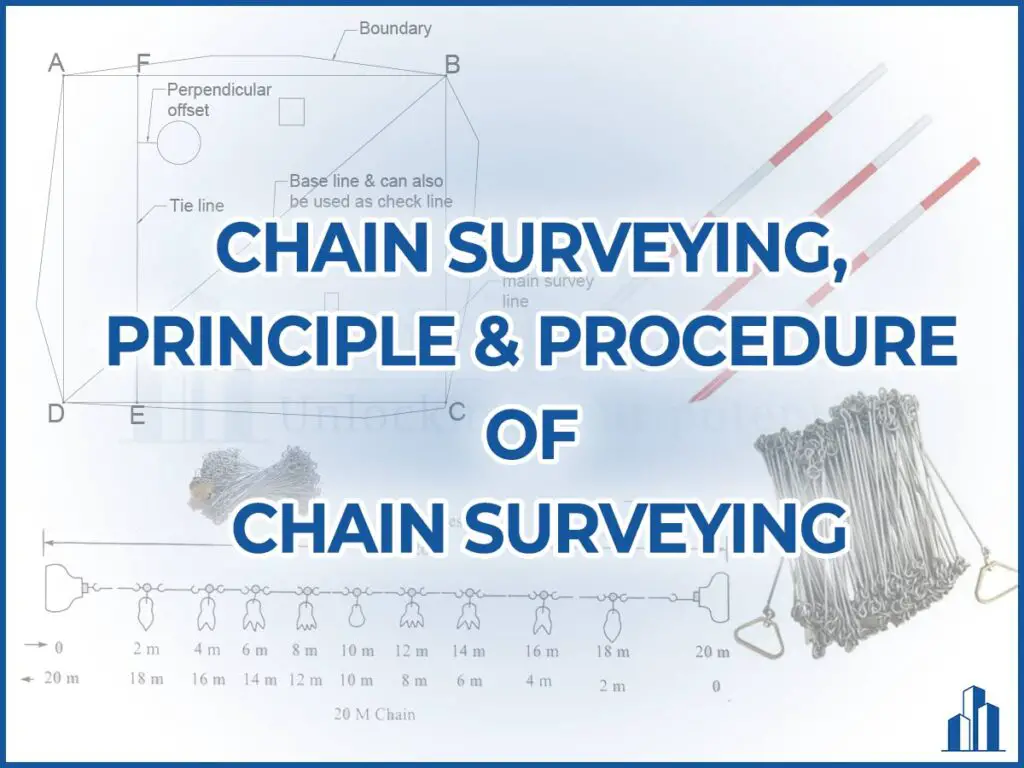There are two main types of compasses used in compass surveying. They are,
- Prismatic compass
- Surveyor’s compass
1.Prismatic compass
This type of Compass is the most convenient, light, and simple instrument and is used for rough surveys where too much accuracy is not needed. This instrument can be either handheld or fitted with a tripod.
The main components of the prismatic compass are,
- Magnetic Needle
- Graduated Ring
- Right angled Prism
- Agate cap
- Eye vane & Object vane
- Pivot
Magnetic needle
- Broad Type Needle
- The magnetic needle does not act as an index while taking the reading
Graduated circle
- The graduated circle is fixed to a broad-type needle and placed on a pivot. Hence it will not rotate with the line of sight.
- Graduations are in Whole Circle Bearing (WCB).
- Graduations are marked Inverted since their reflection is read through the Prism.
- Readings are taken in the clockwise direction with 0° at the South.
- Figures on the ring are written inverted so that they appear in a normal position when looked through the prism.
Right angled prism
- There is a Prism at the Viewing end (eye vane)
- With the help of Prism, the two processes (i.e.) Sighting the object and taking the reading can be performed simultaneously.
Agate cap
- A small piece of hard glass is provided on top of the pivoted joint, to reduce wear and tear at the point of pivot.
Eye vane
- Kept on the prism side of the compass. Silt is provided in the eye vane for ranging and bisecting purposes and also for reading bearing.
Object vane
- Provided to bisect the object. Hair/wire is attached for perfect bisection.
2.Surveyor’s compass
A Surveyor compass is a simple instrument that consists of a graduated circle in a box, an eye vane, and an object vane. It is usually fitted on a tripod.

Magnetic needle
- Edge Type Needle
- The magnetic needle does act as an index while taking the reading
Graduated circle
- The graduated circle is not fixed to an Edge bar-type needle. The graduated circle is fixed to the box and the needle suspends freely and indicating magnetic north always.
- Graduations are in Reduced Bearing (RB).
- The graduations of east and west are interchanged in the circle so that it gives an exact and accurate reading when sighting the object.
No prism
- Since there is no prism, the sighting and reading processes cannot be done simultaneously. For taking reading we have to vertically look into the box.
The object vane and eye vane are the same as of prismatic compass and in surveyor’s compass, there were two bubble tubes fitted perpendicular to each other to level the compass.
Adjustments of compass
There are two adjustments in each compass, they are
- Temporary adjustments
- Permanent adjustments
1) Temporary adjustments of Prismatic compass
Temporary adjustments are those which are made at every setup station of the compass.
Centering
It is the process of keeping the compass exactly over the station. A plumb bob may be used for this process.
Levelling
If the compass is held by a hand or fitted with a tripod, it should be kept in such a way that the graduated circle didn’t touch the bottom of the box. We have to make sure that it suspends freely.
Focusing the prism
The prism attachment can be slide up or down for clear visibility of reading.
2) Permanent adjustments of Prismatic compass
Permanent adjustments are the adjustments that can be only done when the fundamental relationship of the instrument was altered. There is no need to do this adjustment at every setup of the station.
Adjustment of needle
The sensitivity of the needle is checked. It may lose its sensitivity and may suffer a loss of magnetism. Remagnetize the needle if necessary. The balancing of the needle also needs to be checked.
Adjustment of the pivot
Make sure the pivot point didn’t become blunt and exactly at the center of the graduated circle.
3) Temporary adjustments of Surveyor’s compass
Centering
It is the process of keeping the compass exactly over the station. A plumb bob may be used for this process.
Levelling
If the compass is fitted with a tripod, it should be kept in such a way that the suspended edge bar needle didn’t touch the bottom of the box. We have to make sure that it suspends freely.
4) Permanent adjustments of Surveyor’s compass
Adjustment of needle
The sensitivity of the needle is checked. It may lose its sensitivity and may suffer a loss of magnetism. Remagnetise the needle if necessary. The balancing of the needle also needs to be checked.
Adjustment of the pivot
Make sure the pivot point didn’t become blunt and exactly at the center of the graduated circle.
Adjustment of the levels
The surveyor’s compass is fitted with 2 bubble tubes to level them correctly. We have to make sure these levels are perpendicular to the vertical axis when fitted. Rotate the instruments in all directions and adjust the level tube using foot screws.
Adjustment of sight vane
Make sure the sight vane is exactly vertical to the horizontal axis. If the sight vane or the hair in the sight vane is not exactly vertical, try to make it vertical using a plumb bob or change the setup.
Prismatic compass Vs Surveyor’s compass
The summary of main difference between prismatic compass and surveyor’s compass are listed below.
Prismatic compass | Surveyor’s compass |
| 1. The needle is of ‘broad type’ and it does not act as an index while taking reading. | 1. The needle is of ‘Edge bar type’ and it does acts as an index while taking reading. |
| 2. The graduated circle is fixed to the broad type needle. | 2. The graduated circle is fixed to the box of the compass not the needle. |
| 3. The graduations are in Whole Circle Bearing (W.C.B) and engraved inverted since its reflection is read through prism. | 3. The graduations are in Reduced Bearing (R.B) and engraved normally. |
| 4. The reading is taken with the help of prism provided at the eye vane. | 4. The reading is taken by directly see through the top of the glass. |
| 5. Sighting and reading can be done simultaneously. | 5. Sighting and reading cannot be done simultaneously. |
| 6. This instrument can be used even by holding in hand. Tripod may or may not be required. | 6. This Instrument cannot be used without the tripod. |
| 7. Least count of Prismatic compass is 30’ (or) 30 minutes. | 7. Least count of surveyor’s compass is 15’ (or) 15 minutes |





